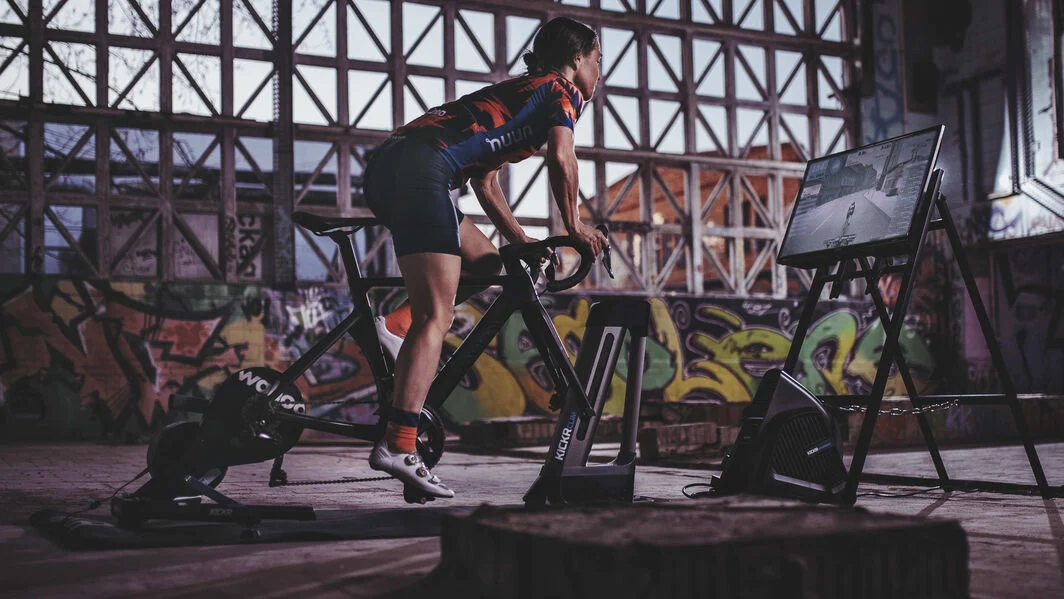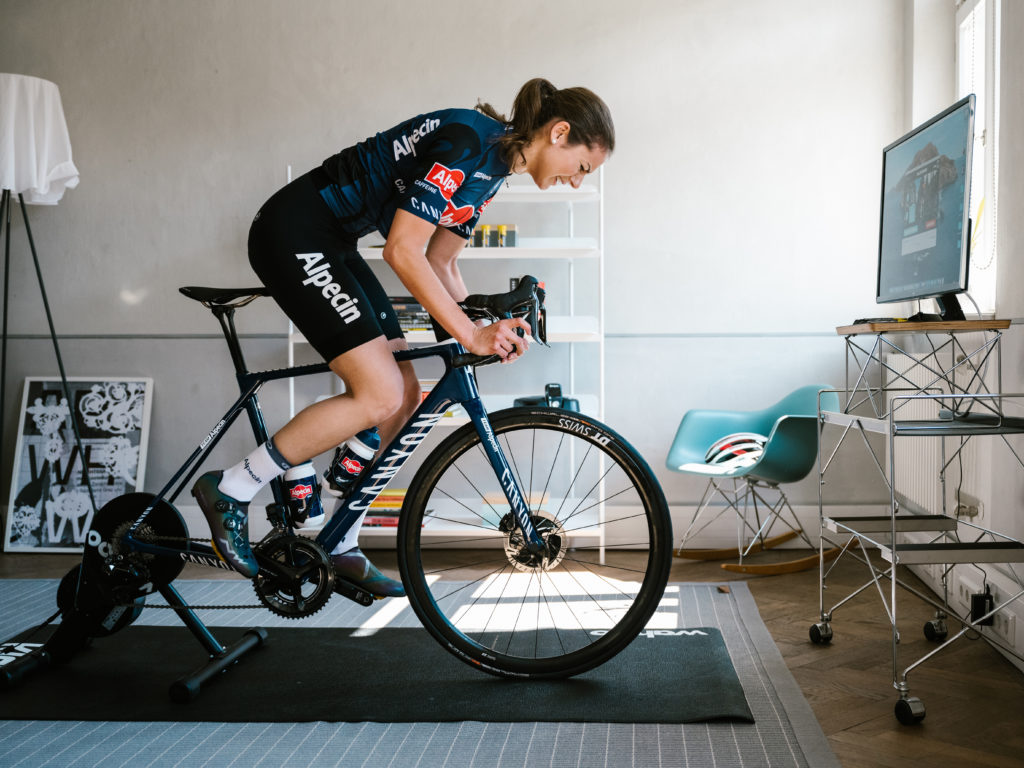Objective Measurement Of Effort
Power meters are crucial to indoor cyclists who rely on a strong foundation of quantitative data to gauge the demands and effectiveness of their training. Real-time power data are not the same as heart rates, which lag behind the effort it takes a cyclist to increase or decrease her pace. Since it provides us with a direct measurement of training effort, we can also target each segment or interval of interest in your training to yield maximal effects based on what you want out of your training.
Instant Performance Tuning
A cyclist can focus on holding a target wattage during intervals using power data, and adjust pedaling effort to be within a specific power zone. This comes in handy especially when you are doing structured workouts where you need to keep a steady effort. When performing a 20 minute interval, a rider aiming for 300 watts can quickly observe if they are too low or too high of 300 watts and can then correct themselves as they go instead of spending that time as guess.
Enhanced Training Specificity
Knowing your power output provides detailed data that can help you fine-tune your workout to meet your specific fitness objectives as a cyclist. It could be a short sharp sprint, a long grind of an effort, or all about working on that nicely rounded aerobic engine birds-eye view image of power offers the specificity that is necessary for these. It is this specificity that makes this possible; simply analyzing the power output data for all sessions, and so highlight the points where you are strongest and where you can make most improvements.
Objective Progress Tracking
Power meters provide quantifiable data that takes the performance tracking to the next level. Using this data, cyclists can directly measure improvements in their fitness between phases of different types of training sessions by comparing power outputs. If your average power output improved from 250 watts to 275 watts over a period of time, you are not probably going to cycle the same 100km faster as well.
Tactical Race Simulation
Training indoors with a power meter also produces race-like conditions, which enables cyclists to dial in their preparation for events. By controlling the power meter to simulate different power levels required for various stages of races and race segments (i.e., climbs, sprints, flat terrain), athletes can develop a race-specific plan and resultant adaptations for performing better in actual races.

Tailored Training Intensity
Greater indoor riders, incorporating those trying to get their choose of training intensity as accurate as possible, will feel the lack of power meters something of staggered omission. It allows athletes to not just find the right wattages for their various levels of fitness and training purposes, but also teach themselves to hold those precise power targets.
Setting Specific Power Zones
Cyclists define their Functional Threshold Power (FTP) (the highest average power can be produced for an hour) with a power meter. Once this baseline is established, cyclists can create their own training zones, from recovery to neuromuscular power. Zone 2 (Endurance) might be 56-75% of FTP, ideal for long steady rides and the other hand Zone 5 (VO2 Max) could be 106–120% of FTP, fit for all-out short bursts.
Structuring Workout Intervals
Having accurately identified power zones, cyclists are able to frame their workout intervals around location-specific energy system development. A rider looking to increase their anaerobic capacity might complete a series of short 120% of FTP intervals, time each effort to hit the necessary metabolic pathway without accumulating excessive fatigue.
Holding Yourself Accountable for Fitness Gains
Power and capacity As cyclists improve, they may increase their ability to produce power. Regular FTP tests to realign the ranges of power zones according to the level of fitness achieved. This ensures that the training remains difficult and successful, encouraging ongoing development.
Real-World Race Preparation
Power meters allow you to replicate what you will see on race day. A cyclist can train according to those demands – if they know a race will have long climbs that require 90% of FTP, they can practice those intensities to ensure success come race day.
Enhanced Motivation With Clear Metrics
By having power meters, indoor cycling enthusiasts receive clearly defined, quantifiable data for instant feedback and with each workout. And this type of immediate feedback is what keeps training motivation high.
Live In-Workout Feedback
With each change in effort, cyclists can immediately see corresponding changes in their power output – increasing the variability of your workout and awarding instant gratification or challenge the rider to push a little bit more. An obvious example would be during a sprint, where the experience of seeing a real-time power output step up from 200 to 250 watts tells a rider instantly that their legs are working harder.
Goal Setting and Achievement
It allows for more specific, measurable goals – like “I want to improve my FTP by 5% during my next block of training”. Meeting these exact targets is a very tangible indicator of stride and success, which is a great motivator.
Competing with Myself and Others
Most indoor cycling platforms are designed to work with power meters, which allow cyclists to challenge others online or simply challenge themselves against previous rides. Competing against personal best and leaderboard scores can dramatically increase motivation. Trying to beat a 20min max power that was your best by 10 watts can be a tricky but doable goal that will motivate you to go to the extra mile.
Visual Progress Tracking
Nearly all power meter-compatible training software includes graphs and analytics. Cyclists also have the ability to see a visible trend of their increasing power over time as they continue to add structure to their training. Which may encourage them even more as they can then visually see where they are on the curve of the fitness journey; that back to back data fitting the line of highest growth.
Accurate Energy Expenditure Calculation
Power-Based Energy Expenditure Calculation Power meters have provided a new level of precision when it comes to quantifying energy output for indoor cyclists. This makes it easy to track how much energy is used, which is important for fine-tuning your exercise and eating plans.
Measure Power Output Directly
When it comes to training associated with power or FTP, using a power meter measures the real power wattage that a cyclist is truly putting out on their indoor bike instead of only seeing virtual power. This measurement is immediate and an accurate reflection of the effort and energy output – no estimations taken from heart rate readings & perceived effort. A flash 60-minute training session at an unassuming 250-watt average converts directly into a specific caloric expenditure, because we know using the formula Calories = Watts×3.6.
Nutritional Intake Calibration
Power data lets cyclists know exactly how many calories they need to take in, which prevents them from eating too little due to not knowing how much to eat, or too much which will lead to weight gain and unwanted energy output. This, in its own right, is important for weight management and peak performance. With this information, a cyclist will know that they burn roughly 800 kcals in a normal training session and can method their meal techniques to meet this outlay and maximise performance and recuperation.
Tailored Recovery Strategies
Knowing the total energy expenditure then allows for appropriate recovery strategies to be put in place. This will then enable cyclists to adjust their recovery foods, fluids and rest to match the freeport intensity of their training. This results in quicker and more effective recovery and results in the ability to train more frequently and with more intensity.
Optimal Interval Training Execution
Interval training is a game-changer for indoor cyclists because power meters make it possible for every single effort to be completed at the appropriate intensity for the best possible payoff. This leads to better training sessions and training to the demands of high-intensity efforts + recreates exact motor patterns and specific movements.
Precision in Power Targets
For interval training the fact that power meters enable cyclists to measure and hold exact power targets for each interval. This means that, if a cyclist is doing intervals at 90% of their FTP, then a power meter guarantees that they remain right in between 270 watts if that is their FTP. This accuracy avoids under or over training, ensuring optimal workout outcomes during every use.
Timing Efficiency
Power meters are key because they provide immediate feedback that precludes interesting ways to pace and recover for riders. A common sequence to qualify the targets being met would be 350w for one minute followed by two minutes at 100w during a typical interval session. This immediate feedback is essential since now one second is lost with the incorrect intensity, both in high intensity intervals and in rest intervals.
Tailored Interval Progression
Power meters create an opportunity to fine tune the progression of intervals for those same cyclists as they mature in training. Analyzing data from prior workouts allows cyclists to increase the intensity or duration of their intervals because fitness levels have increased. If a cyclist who is experiencing relative high but not total failure at the completion of 320 watt intervals, he samples 320 watts at an acceptable stress load then the target may be updated to 340 watts.
Recovery Monitoring
Power meters are also great in terms of watching how well your recovering during intervals. Precise power readings on those short low-intensity intervals makes sure that the is indeed recovering to let the body get ready for the next high-intensity effort. Including this monitoring is crucial because maintaining this balance of effort vs recovery is what makes intervals work!

Prevention Of Overtraining
Power meters are great to help ward off overtraining by giving indoor cyclists a way to measure their training volume objectively. This data-centric decision-making ensures that cyclists ride within their limits and prevent overtraining.
Monitoring Training Stress
Training Stress Score (TSS): A power meter will track and provide you with a TSS score for your session, measuring the cumulative intensity and duration of your workouts. Cyclists can pay close attention to their TSS to verify they are not going over their recovery limit, which is a critical component to prevent overtraining. An easy way to see this could be a cyclist with a weekly recovery threshold of 500 TSS, who would simply design their workouts to not allow them to go over this limit each day.
Moderation In Everything
Power meter data allows cyclists to mix in high-intensity training days with recovery rides. For example, if a power meter has been indicating that a cyclist has consistently being training at high power outputs resulting in high TSS values, more low-intensity sessions may be necessary. Too much fatigue will result in overtraining if not kept in balance.
Signs Of Fatigue Aversions
They are also useful to monitor physiological changes and to recognize early symptoms of overtraining by comparing changes in regular power output. Note that if a rider used to have no difficulty at all holding 300 watts but all of a sudden couldn’t hold 250 watts, he or she would be in trouble, due to over-fatigue or overtraining. Read them early, and you can make modifications to your training, possibly lowering intensity or adding extra day to rest.
Feedback in Recovery
For all cyclists the power data from a power meter is invaluable for measuring recovery needs. If data shows power output and general performance are lower at the end of the training week, it may be a sign of under recovery. Dialing back training volume or intensity may keep the athlete in the pocket between training and recovery with slight to moderate decompensation noted within the recovery window.




